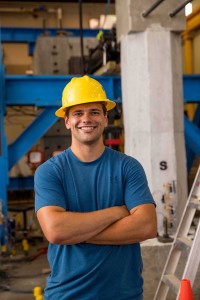Participating in research that could change the bridge construction industry, South Dakota State University graduate student Ted Sjurseth has been named the University Transportation Center Outstanding Student of the Year for the Mountain-Plains Transportation Consortium, a university transportation center formed by eight universities stretching from Utah to North Dakota.
He becomes the first SDSU student to receive the honor since 2014 and only the third overall. Chad Stripling ’06/M.S. ’08 received the award in 2009 and Brittney Ahrenstorff ’12/M.S. ’14 in 2014.
Sjurseth, a 4.0 graduate student in civil engineering from Boyd, Minnesota, is working under assistant professor Mostafa Tazarv to research the use of bridge couplers in high-seismic regions. That wouldn’t include South Dakota, but because of the Lohr Structures Lab in Crothers Engineering Hall, those conditions can be simulated.
The work focuses on testing seven different types of couplers in seven precast concrete columns in the lab’s large capacity hydraulic actuator.
The couplers, formally known as mechanical bar splices, connect sections of rebar within a concrete column. While the couplers can be used in other sections of a bridge column, building codes do not allow the use of the coupler in high-seismic regions at the connection point of the bridge column and footer, Sjurseth explained.
He added there is no practical value to using the bridge couplers at other points if they cannot also be used at the column-footer connection.
Benefit: Faster, lower cost construction
Using the bridge couplers could speed the pace of bridge construction because more work could be done at a precast construction plant rather than on-site. Also, higher quality control could be achieved at the precast plant, said Sjurseth, who earned his bachelor’s degree in civil engineering in 2019 and carried a 3.91 GPA.
The reason couplers are not used now is because of the lack of research to ensure their resistance to failure, Sjurseth explained.
“Test data regarding the performance of mechanically spliced bridge columns is scarce, and the available data is for columns with different geometries, confinement levels and testing procedures. To better understand the seismic performance of mechanically spliced bridge columns, we are testing large-scale precast columns spliced with different bar couplers.
“Establishing a comprehensive precast column experimental database will allow us to verify or further modify the current design methods and might provide a justification to relax the current coupler ban for bridge columns.â€
Sjurseth, who will complete his master’s program in May 2021, joined Tazarv in this research because “it has huge implications around the world. The technology could be used anywhere there are earthquakes. California is one of the biggest regions, but also New York, South Carolina, spots in Missouri, areas where they are fracking now, Japan and elsewhere.â€






